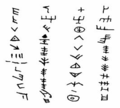In philology, decipherment is the discovery of the meaning of texts written in ancient or obscure languages or scripts.

Linear A is a writing system that was used by the Minoans of Crete from 1800 BC to 1450 BC. Linear A was the primary script used in palace and religious writings of the Minoan civilization. It was succeeded by Linear B, which was used by the Mycenaeans to write an early form of Greek. It was discovered by the archaeologist Sir Arthur Evans in 1900. No texts in Linear A have yet been deciphered. Evans named the script "Linear" because its characters consisted simply of lines inscribed in clay, in contrast to the more pictographic characters in Cretan hieroglyphs that were used during the same period.

Linear B is a syllabic script that was used for writing in Mycenaean Greek, the earliest attested form of the Greek language. The script predates the Greek alphabet by several centuries, the earliest known examples dating to around 1400 BC. It is adapted from the earlier Linear A, an undeciphered script potentially used for writing the Minoan language, as is the later Cypriot syllabary, which also recorded Greek. Linear B, found mainly in the palace archives at Knossos, Kydonia, Pylos, Thebes and Mycenae, disappeared with the fall of Mycenaean civilization during the Late Bronze Age collapse. The succeeding period, known as the Greek Dark Ages, provides no evidence of the use of writing.
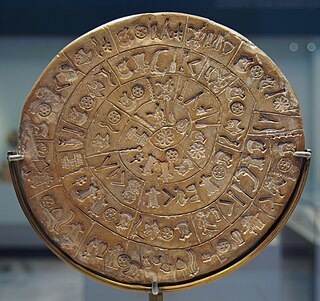
The Phaistos Disc or Phaistos Disk is a disk of fired clay from the island of Crete, Greece, possibly from the middle or late Minoan Bronze Age, bearing a text in an unknown script and language. Its purpose and its original place of manufacture remain disputed. It is now on display at the archaeological museum of Heraklion. The name is sometimes spelled Phaestos or Festos.

Cuneiform is a logo-syllabic writing system that was used to write several languages of the Ancient Near East. The script was in active use from the early Bronze Age until the beginning of the Common Era. Cuneiform scripts are marked by and named for the characteristic wedge-shaped impressions which form their signs. Cuneiform is the earliest known writing system and was originally developed to write the Sumerian language of southern Mesopotamia.

The Vinča symbols or Vinča–Turdaș signs, Old European script, Danube script are a set of untranslated symbols found on Neolithic era artifacts from the Vinča culture and other related "Old European" cultures of Central and Southeastern Europe. Whether this is one of the earliest writing systems or simply symbols of some sort is disputed. They have sometimes been described as an example of proto-writing. The symbols went out of use around 3,500 BC.

Mesoamerican languages are the languages indigenous to the Mesoamerican cultural area, which covers southern Mexico, all of Guatemala, Belize, El Salvador, and parts of Honduras, Nicaragua and Costa Rica. The area is characterized by extensive linguistic diversity containing several hundred different languages and seven major language families. Mesoamerica is also an area of high linguistic diffusion in that long-term interaction among speakers of different languages through several millennia has resulted in the convergence of certain linguistic traits across disparate language families. The Mesoamerican sprachbund is commonly referred to as the Mesoamerican Linguistic Area.

The Cypriot or Cypriote syllabary is a syllabic script used in Iron Age Cyprus, from about the 11th to the 4th centuries BCE, when it was replaced by the Greek alphabet. It has been suggested that the script remained in use as late as the 1st century BC. A pioneer of that change was King Evagoras of Salamis. It is thought to be descended from the Cypro-Minoan syllabary, in turn, a variant or derivative of Linear A. Most texts using the script are in the Arcadocypriot dialect of Greek, but also one bilingual inscription was found in Amathus.
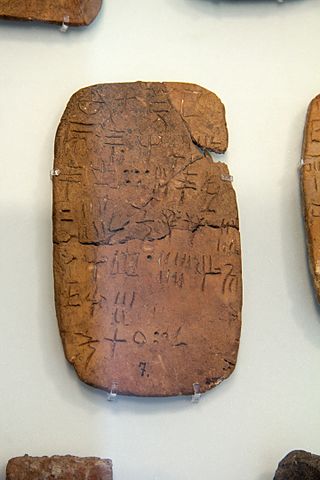
The Minoan language is the language of the ancient Minoan civilization of Crete written in the Cretan hieroglyphs and later in the Linear A syllabary. As the Cretan hieroglyphs are undeciphered and Linear A only partly deciphered, the Minoan language is unknown and unclassified; with the existing evidence, it is impossible to be certain that the two scripts record the same language.

Eteocypriot is an extinct non-Indo-European language that was spoken in Cyprus by a non-Hellenic population during the Iron Age. The name means "true" or "original Cypriot" parallel to Eteocretan, both of which names are used by modern scholars to mean the non-Greek languages of those places. Eteocypriot was written in the Cypriot syllabary, a syllabic script derived from Linear A. The language was under pressure from Arcadocypriot Greek from about the 10th century BC and finally became extinct in about the 4th century BC.

The Isthmian script is an early set of symbols found in inscriptions around the Isthmus of Tehuantepec, dating to c. 500 BCE – 500 CE, though with dates subject to disagreement. It is also called the La Mojarra script and the Epi-Olmec script.
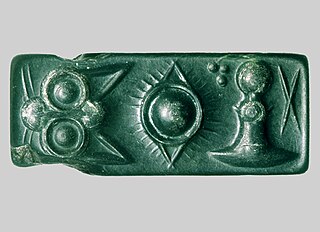
Cretan hieroglyphs are a hieroglyphic writing system used in early Bronze Age Crete, during the Minoan era. They predate Linear A by about a century, but the two writing systems continued to be used in parallel for most of their history. As of 2024, they are undeciphered.
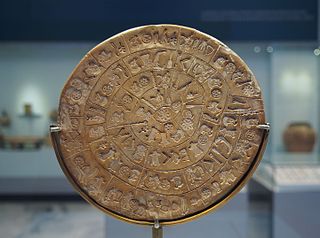
Many people have claimed to have deciphered the Phaistos Disc.
The Cypro-Minoan syllabary (CM), more commonly called the Cypro-Minoan Script, is an undeciphered syllabary used on the island of Cyprus and at its trading partners during the late Bronze Age and early Iron Age. The term "Cypro-Minoan" was coined by Arthur Evans in 1909 based on its visual similarity to Linear A on Minoan Crete, from which CM is thought to be derived. Approximately 250 objects—such as clay balls, cylinders, and tablets which bear Cypro-Minoan inscriptions, have been found. Discoveries have been made at various sites around Cyprus, as well as in the ancient city of Ugarit on the Syrian coast. It is thought to be somehow related to the later Cypriot syllabary.
Aegean script or Cretan script refers to a group of scripts that originate from the island of Crete. It may also refer to:
Mesoamerica, along with Mesopotamia and China, is one of three known places in the world where writing is thought to have developed independently. Mesoamerican scripts deciphered to date are a combination of logographic and syllabic systems. They are often called hieroglyphs due to the iconic shapes of many of the glyphs, a pattern superficially similar to Egyptian hieroglyphs. Fifteen distinct writing systems have been identified in pre-Columbian Mesoamerica, many from a single inscription. The limits of archaeological dating methods make it difficult to establish which was the earliest and hence the progenitor from which the others developed. The best documented and deciphered Mesoamerican writing system, and the most widely known, is the classic Maya script. Earlier scripts with poorer and varying levels of decipherment include the Olmec hieroglyphs, the Zapotec script, and the Isthmian script, all of which date back to the 1st millennium BC. An extensive Mesoamerican literature has been conserved, partly in indigenous scripts and partly in postconquest transcriptions in the Latin script.
The Aztec or Nahuatl script is a pre-Columbian writing system that combines their writing with very specific phonetic logograms and syllabic signs which was used in central Mexico by the Nahua people.
Olmec hieroglyphs are a set of glyphs developed within the Olmec culture. The Olmecs were the earliest known major Mesoamerican civilization, flourishing during the formative period in the tropical lowlands of the modern-day Mexican states of Veracruz and Tabasco. The subsequent Epi-Olmec culture, was a successor culture to the Olmec and featured the Isthmian script, which has been characterized as a full-fledged writing system, though with its partial decipherment being disputed.

The Paleo-European languages, or Old European languages, are the mostly unknown languages that were spoken in Europe prior to the spread of the Indo-European and Uralic families caused by the Bronze Age invasion from the Eurasian steppe of pastoralists whose descendant languages dominate the continent today. Today, the vast majority of European populations speak Indo-European languages, but until the Bronze Age, it was the opposite, with Paleo-European languages of non-Indo-European affiliation dominating the linguistic landscape of Europe.





